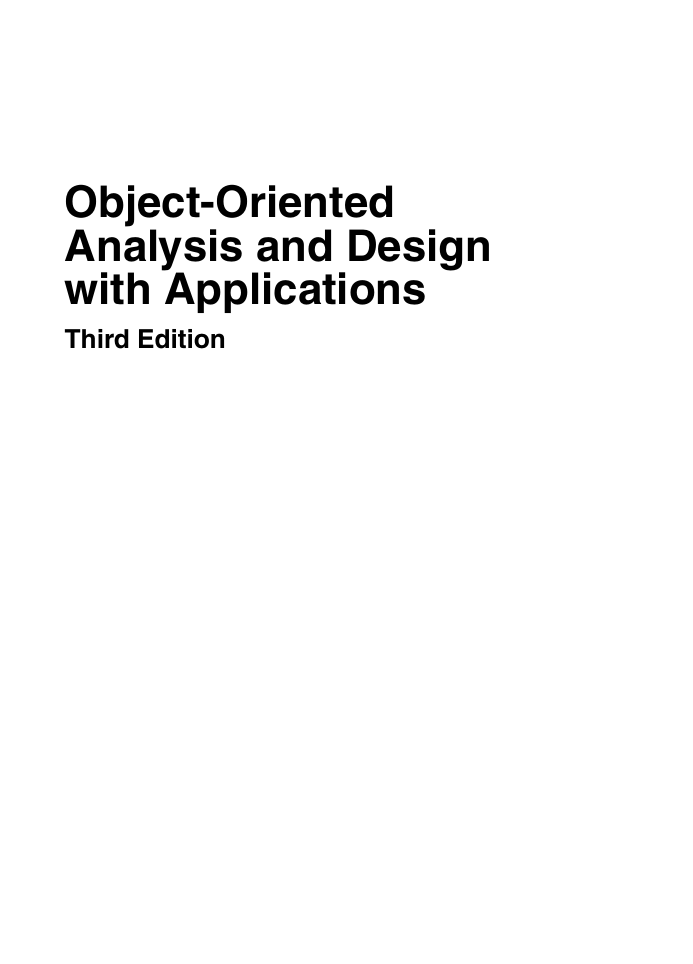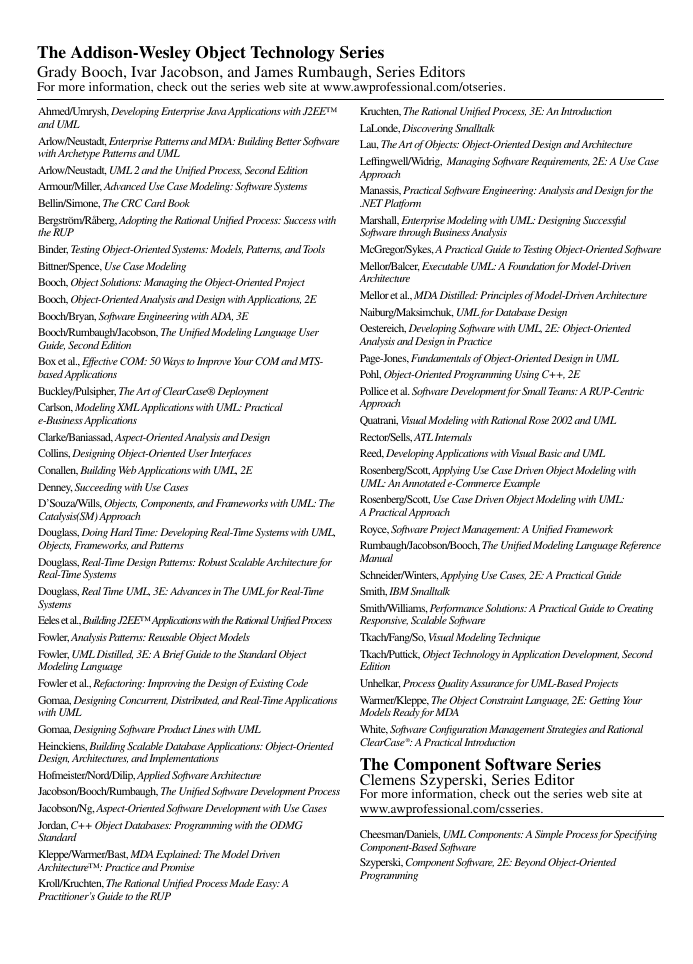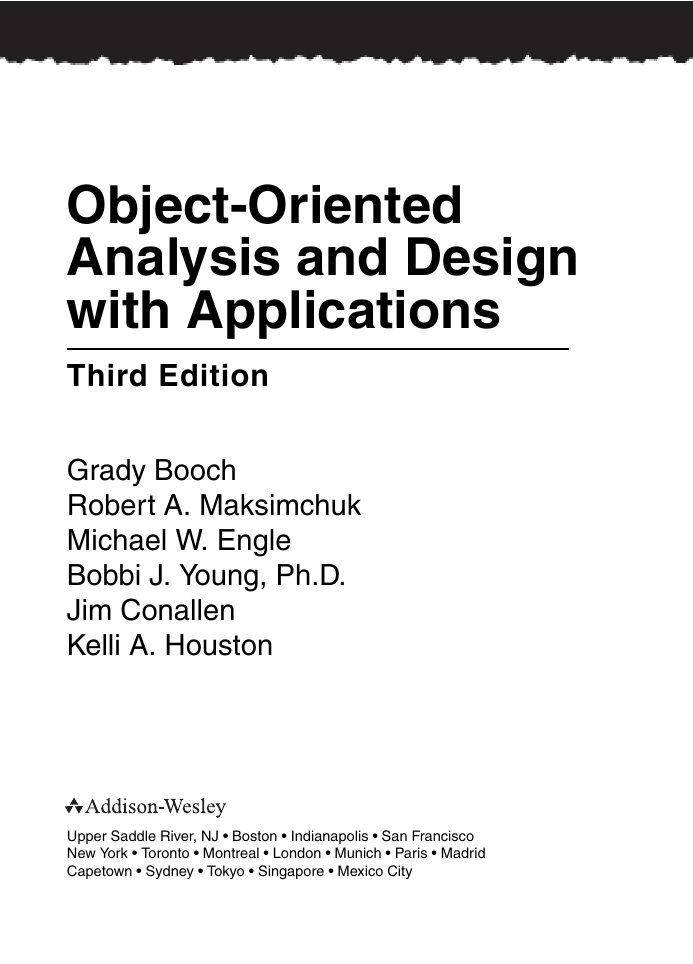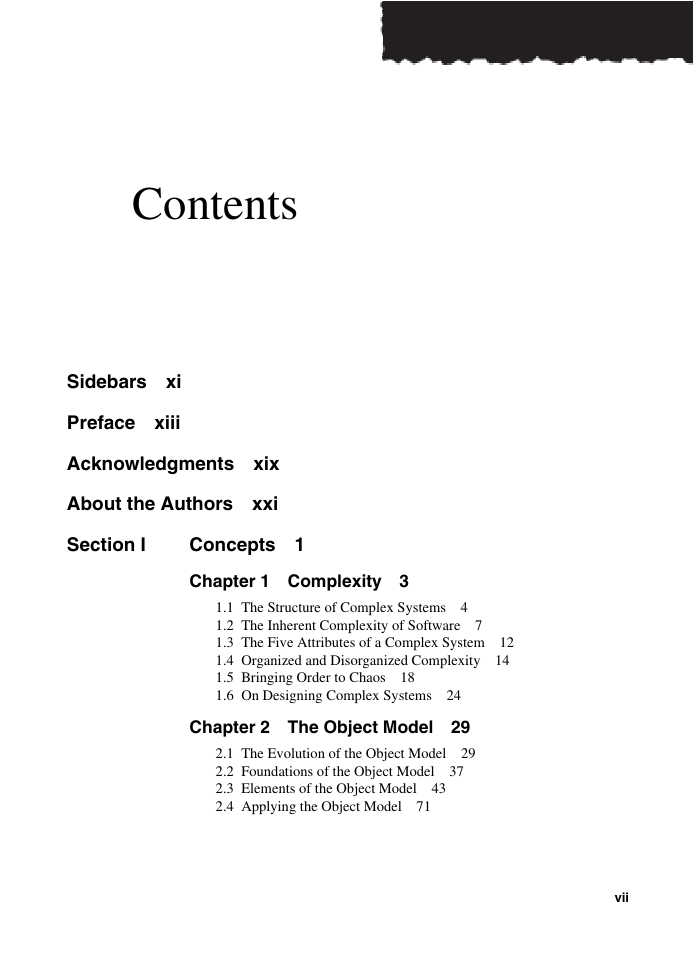�
Object-Oriented
Analysis and Design
with Applications
Third Edition
The Addison-Wesley Object Technology Series
Grady Booch, Ivar Jacobson, and James Rumbaugh, Series Editors
For more information, check out the series web site at www.awprofessional.com/otseries.
Ahmed/Umrysh, Developing Enterprise Java Applications with J2EE™
and UML
Arlow/Neustadt, Enterprise Patterns and MDA: Building Better Software
with Archetype Patterns and UML
Arlow/Neustadt, UML 2 and the Unified Process, Second Edition
Armour/Miller, Advanced Use Case Modeling: Software Systems
Bellin/Simone, The CRC Card Book
Bergström/Råberg, Adopting the Rational Unified Process: Success with
the RUP
Binder, Testing Object-Oriented Systems: Models, Patterns, and Tools
Bittner/Spence, Use Case Modeling
Booch, Object Solutions: Managing the Object-Oriented Project
Booch, Object-Oriented Analysis and Design with Applications, 2E
Booch/Bryan, Software Engineering with ADA, 3E
Booch/Rumbaugh/Jacobson, The Unified Modeling Language User
Guide, Second Edition
Box et al., Effective COM: 50 Ways to Improve Your COM and MTS-
based Applications
Buckley/Pulsipher, The Art of ClearCase® Deployment
Carlson, Modeling XML Applications with UML: Practical
e-Business Applications
Clarke/Baniassad, Aspect-Oriented Analysis and Design
Collins, Designing Object-Oriented User Interfaces
Conallen, Building Web Applications with UML, 2E
Denney, Succeeding with Use Cases
D’Souza/Wills, Objects, Components, and Frameworks with UML: The
Catalysis(SM) Approach
Douglass, Doing Hard Time: Developing Real-Time Systems with UML,
Objects, Frameworks, and Patterns
Douglass, Real-Time Design Patterns: Robust Scalable Architecture for
Real-Time Systems
Douglass, Real Time UML, 3E: Advances in The UML for Real-Time
Systems
Eeles et al., Building J2EE™Applications with the Rational Unified Process
Fowler, Analysis Patterns: Reusable Object Models
Fowler, UML Distilled, 3E: A Brief Guide to the Standard Object
Modeling Language
Fowler et al., Refactoring: Improving the Design of Existing Code
Gomaa, Designing Concurrent, Distributed, and Real-Time Applications
with UML
Gomaa, Designing Software Product Lines with UML
Heinckiens, Building Scalable Database Applications: Object-Oriented
Design, Architectures, and Implementations
Hofmeister/Nord/Dilip, Applied Software Architecture
Jacobson/Booch/Rumbaugh, The Unified Software Development Process
Jacobson/Ng, Aspect-Oriented Software Development with Use Cases
Jordan, C++ Object Databases: Programming with the ODMG
Standard
Kleppe/Warmer/Bast, MDA Explained: The Model Driven
Architecture™: Practice and Promise
Kroll/Kruchten, The Rational Unified Process Made Easy: A
Practitioner’s Guide to the RUP
Kruchten, The Rational Unified Process, 3E: An Introduction
LaLonde, Discovering Smalltalk
Lau, The Art of Objects: Object-Oriented Design and Architecture
Leffingwell/Widrig, Managing Software Requirements, 2E: A Use Case
Approach
Manassis, Practical Software Engineering: Analysis and Design for the
.NET Platform
Marshall, Enterprise Modeling with UML: Designing Successful
Software through Business Analysis
McGregor/Sykes, A Practical Guide to Testing Object-Oriented Software
Mellor/Balcer, Executable UML: A Foundation for Model-Driven
Architecture
Mellor et al., MDA Distilled: Principles of Model-Driven Architecture
Naiburg/Maksimchuk, UML for Database Design
Oestereich, Developing Software with UML, 2E: Object-Oriented
Analysis and Design in Practice
Page-Jones, Fundamentals of Object-Oriented Design in UML
Pohl, Object-Oriented Programming Using C++, 2E
Pollice et al. Software Development for Small Teams: A RUP-Centric
Approach
Quatrani, Visual Modeling with Rational Rose 2002 and UML
Rector/Sells, ATL Internals
Reed, Developing Applications with Visual Basic and UML
Rosenberg/Scott, Applying Use Case Driven Object Modeling with
UML: An Annotated e-Commerce Example
Rosenberg/Scott, Use Case Driven Object Modeling with UML:
A Practical Approach
Royce, Software Project Management: A Unified Framework
Rumbaugh/Jacobson/Booch, The Unified Modeling Language Reference
Manual
Schneider/Winters, Applying Use Cases, 2E: A Practical Guide
Smith, IBM Smalltalk
Smith/Williams, Performance Solutions: A Practical Guide to Creating
Responsive, Scalable Software
Tkach/Fang/So, Visual Modeling Technique
Tkach/Puttick, Object Technology in Application Development, Second
Edition
Unhelkar, Process Quality Assurance for UML-Based Projects
Warmer/Kleppe, The Object Constraint Language, 2E: Getting Your
Models Ready for MDA
White, Software Configuration Management Strategies and Rational
ClearCase®: A Practical Introduction
The Component Software Series
Clemens Szyperski, Series Editor
For more information, check out the series web site at
www.awprofessional.com/csseries.
Cheesman/Daniels, UML Components: A Simple Process for Specifying
Component-Based Software
Szyperski, Component Software, 2E: Beyond Object-Oriented
Programming
�
Object-Oriented
Analysis and Design
with Applications
Third Edition
Grady Booch
Robert A. Maksimchuk
Michael W. Engle
Bobbi J. Young, Ph.D.
Jim Conallen
Kelli A. Houston
Upper Saddle River, NJ • Boston • Indianapolis • San Francisco
New York • Toronto • Montreal • London • Munich • Paris • Madrid
Capetown • Sydney • Tokyo • Singapore • Mexico City
�
Many of the designations used by manufacturers and sellers to distinguish their products are claimed as trademarks.
Where those designations appear in this book, and the publisher was aware of a trademark claim, the designations have
been printed with initial capital letters or in all capitals.
The authors and publisher have taken care in the preparation of this book, but make no expressed or implied warranty of
any kind and assume no responsibility for errors or omissions. No liability is assumed for incidental or consequential
damages in connection with or arising out of the use of the information or programs contained herein.
The publisher offers excellent discounts on this book when ordered in quantity for bulk purchases or special sales, which
may include electronic versions and/or custom covers and content particular to your business, training goals, marketing
focus, and branding interests. For more information, please contact:
U.S. Corporate and Government Sales
(800) 382-3419
corpsales@pearsontechgroup.com
For sales outside the United States please contact:
International Sales
international@pearsoned.com
Visit us on the Web: www.awprofessional.com
Library of Congress Cataloging-in-Publication Data
Object-oriented analysis and design with applications / Grady Booch...[et
al.]. — 3rd ed.
p. cm.
Rev. ed. of: Object-oriented analysis and design with applications / Grady
Booch, 2nd ed.
Includes bibliographical references and index.
ISBN 0-201-89551-X (hardback : alk. paper)
1. Object-oriented programming (Computer science) I. Booch, Grady. II.
Booch, Grady. Object-oriented analysis and design with applications.
QA76.64.B66 2007
005.1'17—dc22
Copyright © 2007 Pearson Education, Inc.
2007002589
All rights reserved. Printed in the United States of America. This publication is protected by copyright, and permission
must be obtained from the publisher prior to any prohibited reproduction, storage in a retrieval system, or transmission in
any form or by any means, electronic, mechanical, photocopying, recording, or likewise. For information regarding
permissions, write to:
Pearson Education, Inc.
Rights and Contracts Department
75 Arlington Street, Suite 300
Boston, MA 02116
Fax: (617) 848-7047
ISBN 0-201-89551-X
Text printed in the United States on recycled paper at Courier in Westford, Massachusetts.
First printing, April 2007
�
To Jan
my friend, my lover, my wife
—Grady
�
This page intentionally left blank
�
Contents
Sidebars xi
Preface xiii
Acknowledgments xix
About the Authors xxi
Section I
Concepts 1
Chapter 1 Complexity 3
1.1 The Structure of Complex Systems 4
1.2 The Inherent Complexity of Software
1.3 The Five Attributes of a Complex System 12
1.4 Organized and Disorganized Complexity 14
1.5 Bringing Order to Chaos 18
1.6 On Designing Complex Systems
24
7
Chapter 2 The Object Model 29
2.1 The Evolution of the Object Model 29
2.2 Foundations of the Object Model
2.3 Elements of the Object Model
2.4 Applying the Object Model
37
43
71
vii
�
















 2023年江西萍乡中考道德与法治真题及答案.doc
2023年江西萍乡中考道德与法治真题及答案.doc 2012年重庆南川中考生物真题及答案.doc
2012年重庆南川中考生物真题及答案.doc 2013年江西师范大学地理学综合及文艺理论基础考研真题.doc
2013年江西师范大学地理学综合及文艺理论基础考研真题.doc 2020年四川甘孜小升初语文真题及答案I卷.doc
2020年四川甘孜小升初语文真题及答案I卷.doc 2020年注册岩土工程师专业基础考试真题及答案.doc
2020年注册岩土工程师专业基础考试真题及答案.doc 2023-2024学年福建省厦门市九年级上学期数学月考试题及答案.doc
2023-2024学年福建省厦门市九年级上学期数学月考试题及答案.doc 2021-2022学年辽宁省沈阳市大东区九年级上学期语文期末试题及答案.doc
2021-2022学年辽宁省沈阳市大东区九年级上学期语文期末试题及答案.doc 2022-2023学年北京东城区初三第一学期物理期末试卷及答案.doc
2022-2023学年北京东城区初三第一学期物理期末试卷及答案.doc 2018上半年江西教师资格初中地理学科知识与教学能力真题及答案.doc
2018上半年江西教师资格初中地理学科知识与教学能力真题及答案.doc 2012年河北国家公务员申论考试真题及答案-省级.doc
2012年河北国家公务员申论考试真题及答案-省级.doc 2020-2021学年江苏省扬州市江都区邵樊片九年级上学期数学第一次质量检测试题及答案.doc
2020-2021学年江苏省扬州市江都区邵樊片九年级上学期数学第一次质量检测试题及答案.doc 2022下半年黑龙江教师资格证中学综合素质真题及答案.doc
2022下半年黑龙江教师资格证中学综合素质真题及答案.doc